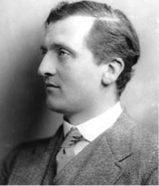 Thomas Ernest Hulme, often referred to as T. E. Hulme, was an English poet who was also an art and literary critic and occasional writer of political articles. He lived at a tragic time for the world of course and was one of the growing movement of modernist writers and artists whose work was influenced by the onset of the First World War. As an aesthetic philosopher he became known as the “father of imagism”. Tragically, his life was cut short on the bloody battlefields of Flanders and the memorial stone in the cemetery describes him as “One of the War Poets”.
Thomas Ernest Hulme, often referred to as T. E. Hulme, was an English poet who was also an art and literary critic and occasional writer of political articles. He lived at a tragic time for the world of course and was one of the growing movement of modernist writers and artists whose work was influenced by the onset of the First World War. As an aesthetic philosopher he became known as the “father of imagism”. Tragically, his life was cut short on the bloody battlefields of Flanders and the memorial stone in the cemetery describes him as “One of the War Poets”.
He was born on the 16th September 1883 into comfortable circumstances at Gratton Hall, in the small Staffordshire village of Endon. Early education at Newcastle-under-Lyme High School was followed by two years reading mathematics at St John’s College, Cambridge. Unfortunately, high-spiritedness on Boat Race night and indiscretion with a girl from Roedean School resulted in being sent down twice from the college. He did, though, attend University College London later on, in order to complete his studies.
Hulme followed this, as many students have done, with a period of travel. He traversed Canada and then mainland Europe, studying languages wherever he could. At the age of 24 he took up his interest in philosophy and was able to translate a number of works on the subject by German and French writers. As his knowledge and interest grew he began to write articles of his own, which found publication in The New Age magazine.
This led to his exploration of imagist poetry and he began writing poems such as City Sunset and one reproduced here – a short piece called Autumn:

These two, considered to be the first two imagist poems, were published in the Poets’ Club anthology in 1909, an organisation which Hulme was the first secretary of when it was set up, in London, in 1908. The group attracted well-known names such as Henry Newbolt, Edmund Gosse and Ezra Pound. Hulme wrote around twenty five separate poems, all highly descriptive, offering evocative imagery to the reader through his clever use of the language. Titles included Town Sky-line, The Man in the Crow”s Nest and A Tall Woman.
His work was much admired by other writers such as the American Robert Frost. The pair met in 1913, probably after Hulme had done most of his writing. He did, however, continue to contribute pieces for The New Age after the outbreak of the First World War. He wrote under two pseudonyms: “North Staffs” and “A Notebook” while serving in France and Belgium in artillery units.
He was wounded in 1916, but it was not enough to earn him an honourable discharge. Instead he returned to the front and was killed the following year when he was blown to pieces by a falling shell near the West Flanders town of Nieuwpoort. While others around him had thrown themselves to the ground to protect themselves, Hulme seemed oblivious to the incoming missile and took the full force of the blast from a standing position.

